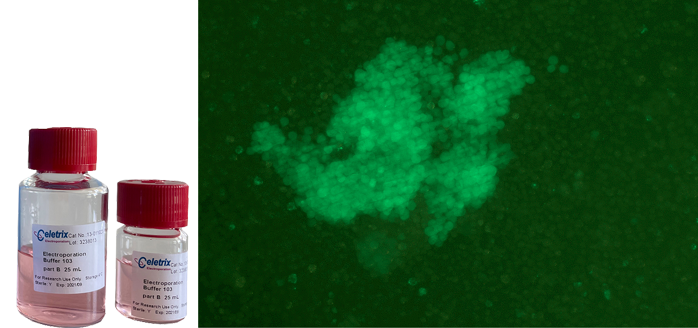- Electroporation by Celetrix
- Special Cells
Special cells
While Celetrix electroporation does not care much about cell names, there are certain cell types that do require extra attention due to their special biological properties.
Many monocyte or macrophage related cell lines such as THP-1, U937, HL-60 and Molm13 will die out within two to three days after plasmid electroporation. There will be surviving cells with other older electroporation technologies but this doesn’t help because those surviving cells were not electroporated due to the lower efficiency.
Celetrix has developed the THP-1 Helper Kit for plasmid electroporation of monocytic cell lines. A significant portion of THP-1 and U937 cells can survive and grow with the helper kit, enabling easy generation of stable cell lines. Starting from just 1x10E6 cells, THP-1 cells electroporated with Cas9-gRNA-GFP-Puro plasmid stably incorporated the plasmid with puromycin selection and gene editing was also successful.

These cells have no problem with mRNA, siRNA and Cas9 RNP electroporation. The efficiency would be nearly 100% and cell survival is not affected.
Our THP-1 Helper Kit does not help cell lines such as Molm13 and SUP-M2 with plasmid electroporation and we are actively researching the solutions.
Mouse primary bone marrow monocytes and hematopoietic stem cells are very special in that they tend to die after plasmid electroporation and meanwhile, they can degrade mRNA and siRNA quickly to make electroporation appear unsuccessful. When mRNA in electroporation buffer is mixed with these cells for less than one minute and the centrifuged buffer with mRNA is used to electroporate Jurkat cell line, the mRNA is already completely degraded. Mouse spleen cells also degrade mRNA and siRNA quickly. As a lucky break, mature mouse peritoneal macrophages can be electroporated with mRNA at high efficiency.
Celetrix Users can email us for suggestions if there are difficulties in the experiment.
Celetrix Users can email us for suggestions if there are difficulties in the experiment.

